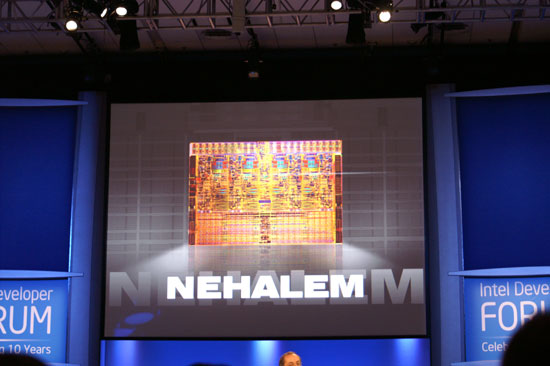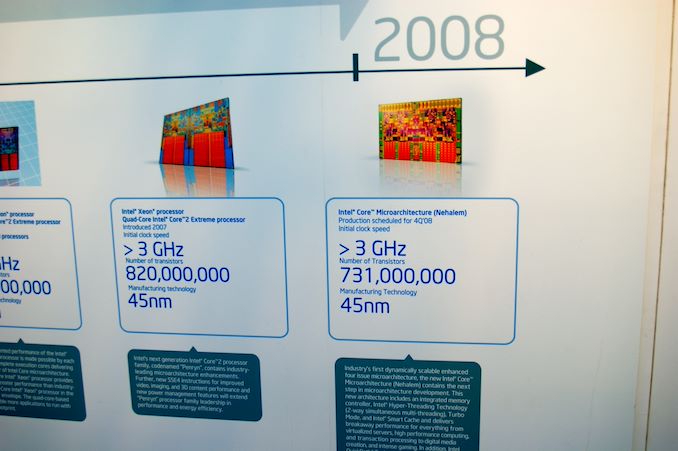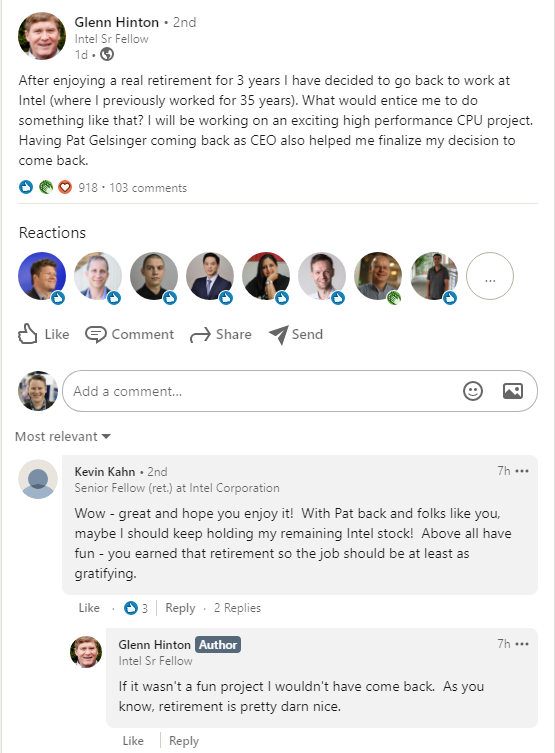New Intel CEO Making Waves: Rehiring Retired CPU Architects
by Dr. Ian Cutress on January 21, 2021 5:05 AM EST- Posted in
- CPUs
- Intel
- Nehalem
- Pat Gelsinger

We’re following the state of play with Intel’s new CEO, Pat Gelsinger, very closely. Even as an Intel employee for 30 years, rising to the rank of CTO, then taking 12 years away from the company, his arrival has been met with praise across the spectrum given his background and previous successes. He isn’t even set to take his new role until February 15th, however his return is already causing a stir with Intel’s current R&D teams.
News in the last 24 hours, based on public statements, states that former Intel Senior Fellow Glenn Hinton, who lists being the lead architect of Intel’s Nehalem CPU core in his list of achievements, is coming out of retirement to re-join the company. (The other lead architect of Nehalem are Ronak Singhal and Per Hammerlund - Ronak is still at Intel, working on next-gen processors, while Per has been at Apple for five years.)
Hinton is an old Intel hand, with 35 years of experience, leading microarchitecture development of Pentium 4, one of three senior architects of Intel’s P6 processor design (which led to Pentium Pro, P2, P3), and ultimately one of the drivers to Intel’s Core architecture which is still at the forefront of Intel’s portfolio today. He also a lead microarchitect for Intel’s i960 CA, the world’s first super-scalar microprocessor. Hinton holds more than 90+ patents from 8 CPU designs from his endeavors. Hinton spent another 10+ years at Intel after Nehalem, but Nehalem is listed in many places as his primary public achievement at Intel.
On his social media posts, Hinton states that he will be working on ‘an exciting high performance CPU project’. In the associated comments also states that ‘if it wasn’t a fun project I wouldn’t have come back – as you know, retirement is pretty darn nice’. Glenn also discloses that he has been pondering the move since November, and Gelsinger’s re-hiring helped finalize that decision. His peers also opine that Glenn is probably not the only ex-Intel architect that might be heading back to the company. We know a few architects and specialists that have left Intel in recent years to join Intel's competitors, such as AMD and Apple.
There are a few key things to note here worth considering.
First is that coming out of retirement for a big CPU project isn’t a trivial thing, especially for an Intel Senior Fellow. Given Intel’s successes, one would assume that the financial situation is not the main driver here, but the opportunity to work on something new and exciting. Plus, these sorts of projects take years of development, at least three, and thus Glenn is signing on for a long term despite already having left to retire.
Second point is reiterating that last line – whatever project Glenn is working on, it will be a long term project. Assuming that Glenn is talking about a fresh project within Intel’s R&D ecosystem, it will be 3-5 years before we see the fruits of the labor, which also means creating a design aimed at what could be a variety of process node technologies. Glenn’s expertise as lead architect is quite likely applicable for any stage of an Intel R&D design window, but is perhaps best served from the initial stages. The way Glenn seems to put it, this might be a black-ops style design. It also doesn't specify if this is x86, leaving that door open to speculation.
Third here is to recognize that Intel has a number of processor design teams in-house and despite the manufacturing process delays, they haven’t been idle. We’ve been seeing refresh after refresh of Skylake lead Intel's portfolio, and while the first iterations of the 10nm Cove cores come to market, Intel’s internal design teams would have been working on the next generation, and the next generation after that – the only barrier to deployment would have been manufacturing. I recall a discussion with Intel’s engineers around Kaby Lake time, when I asked about Intel’s progress on IPC – I requested a +10% gen-on-gen increase over the next two years at the time, and I was told that those designs were done and baked – they were already working on the ones beyond that. Those designs were likely Ice/Tiger Lake, and so Intel’s core design teams have been surging ahead despite manufacturing issues, and I wonder if there’s now a 3-4 year (or more) delay on some of these designs. If Glenn is hinting at a project beyond that, then we could be waiting even longer.
Fourth and finally, one of the critical elements listed by a number of analysts on the announcement of Gelsinger’s arrival was that he wouldn’t have much of an effect until 3+ years down the line, because of how product cycles work. I rejected that premise outright, stating that Pat can come in and change elements of Intel’s culture immediately, and could sit in the room with the relevant engineers and discuss product design on a level that Bob Swan cannot. Pat has the opportunity to arrange the leadership structure and instill new confidence in those structures, some of which may have caused key architects in the past to retire, instead of build on exciting projects.
As we can see, Pat is already having an effect before his name is even on the door at HQ.
Today is also Intel’s end-of-year financial disclosure, at 5pm ET. We are expecting Intel’s current CEO, Bob Swan, to talk through what looks to be another record breaking year of revenue, and likely the state of play for Intel's own 7nm process node technologies. That last point is somewhat thrown into doubt given the new CEO announcement and if Gelsinger is on the call. It is unknown if Gelsinger will participate.
Related Reading
- Intel Appoints Pat Gelsinger as New CEO, From Feb 15th
- An Interview with Intel CEO Bob Swan: Roundtable Q&A on Fabs and Future
- Robert Swan Named CEO of Intel













112 Comments
View All Comments
Lord of the Bored - Friday, January 22, 2021 - link
I'd wager some of those are already having offers tossed their way. But that won't make news like "co-creator of the Pentium II/III" will.Rictorhell - Thursday, January 21, 2021 - link
I'm hoping for the best for Intel, despite my opinions about their business practices over the last few decades. As far as computing has come, and for all the progress that has been made, I still feel like we are technologically stunted, or blocked, in a lot of ways. The cost of developing and manufacturing CPUs is so high that only a handful of companies and individuals can afford to do it, and invest in it.Everyone in these companies has to basically bide their time. They are all at the beck and call of the higher ups in the individual companies, that are interested in profits, profits, profits.
Even when a breakthrough is made, there is a strategy employed as to how and when to implement the breakthrough, and how quickly or how slowly to roll it out and implement it into actual productts.
From my point of view, nothing is going to spur innovation and growth, outside of serious, meaningful competition, amongst these companies. If one company isn't performing well, or is, for all intents and purposes, a lame duck, then that places their competitors in a position where they can comfortably slow down, and hold back, where they might otherwise have increased their efforts and pushed forward.
We're in 2021, but to me, the technology isn't 2021 technology, the technology is lagging years behind where it COULD be, or where it MIGHT be.
If there is this hidden gem of IPC improvements and other advances that are out there, just waiting to be set free, nothing is going to set it free like competition and genuine enthusiasm, amongst these companies.
pxl9190 - Saturday, January 23, 2021 - link
you think too highly of the architects and their employers. 15 to 20% IPC gain in a generation is highly non trivial and is only achieved once every few generations.the amount of engineering that is needed per every single % ipc gain across a wide spectrum of workload is more than you think . it is naturally done rev by rev....
vFunct - Thursday, January 21, 2021 - link
I hope they work on something post x86, as ARM pretty much is cleaning up there. Maybe they can work on something with RISC-V or a new architecture (not that weird Itanium crap..)At this point, ARM is their main competitor, and the only viable challenger I see to it is RISC-V, with a potential 2x improvement in efficiency compared to ARM.
kgardas - Thursday, January 21, 2021 - link
I also think that for Intel to release some RISC-V SoC on latest Atom level performance would at least a bit undermine ARM movement which would be a good thing for them. Just to buy some time...Wilco1 - Thursday, January 21, 2021 - link
What would the point of that be? RISC-V doesn't run on Windows or Android, and latest Atom is far behind recent Arm cores.kgardas - Thursday, January 21, 2021 - link
Make a wave(s). Intel needs (a) improve manufacturing of 10nm/7nm/etc and (b) a little bit brake ARM. RISC-V may be the right weapon to attack from the bottom. In comparison with current RISC-V SoCs, latest Atom cores are fine.mode_13h - Saturday, January 23, 2021 - link
If Android doesn't already support RISC-V, then it's only a matter of time. Linux has already supported it for a few years, now. That means the kernel and toolchain support are already there.mode_13h - Saturday, January 23, 2021 - link
The main problem with Atom cores is Intel's manufacturing node. Tremont is good and Gracemont will be even better.Atom isn't supposed to compete with ARM's fastest cores, either. It's mostly making a play for the mid-range of efficiency and performance that you find in Chromebooks and on SBCs. Still, it does suffer from the x86 tax.
name99 - Thursday, January 21, 2021 - link
"Assuming that Glenn is talking about a fresh project within Intel’s R&D ecosystem, it will be 3-5 years before we see the fruits of the labor"That seems overly optimistic.
From slides presented at Stanford by, ... checks notes ..., Glenn Hinton...:
Nehalem started in 2003 (with research even earlier)
https://web.stanford.edu/class/ee380/Abstracts/100...
and was released at the very end of 2008. (Of course that was back in the day when "release" meant something like "can buy it within a few weeks", not today's "step 17 of a 37 step fan dance before you will actually own one".)